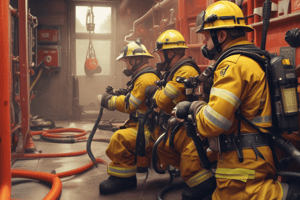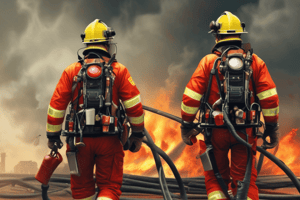Podcast
Questions and Answers
How should a fire hose be cleaned?
How should a fire hose be cleaned?
- Using a high-pressure water stream
- Using a low-pressure water stream (correct)
- Using only a cloth
- Using industrial detergents
What should be done if a hose is found to be damaged?
What should be done if a hose is found to be damaged?
- It should continue to be used until a replacement is found
- It should be discarded
- It should be repaired immediately
- It should be removed from service and tagged (correct)
What is the final step in the cleaning process of a fire hose?
What is the final step in the cleaning process of a fire hose?
- Drying the hose outside in the sun
- Hanging the hose vertically
- Drying the hose with a towel
- Drying the hose inside away from UV light (correct)
When a hose is retired from service, what happens to the couplings?
When a hose is retired from service, what happens to the couplings?
What should you use to clean nozzles, adapters, and fittings?
What should you use to clean nozzles, adapters, and fittings?
Which action helps keep nozzles, adapters, and appliances in good working condition?
Which action helps keep nozzles, adapters, and appliances in good working condition?
What should be used to scrub the entire length of a fire hose?
What should be used to scrub the entire length of a fire hose?
What should be ensured about couplings during fire hose cleaning?
What should be ensured about couplings during fire hose cleaning?
What should be done to maintain the male coupling threads?
What should be done to maintain the male coupling threads?
What should fire hose retired from service be updated in?
What should fire hose retired from service be updated in?
Flashcards are hidden until you start studying
Study Notes
Hose Cleaning and Maintenance
- Fire hoses should be cleaned periodically and after use to ensure they remain in good condition.
- Thoroughly rinse the fire hose with clean water using a low-pressure water stream to avoid pushing contaminants into the hose jacket.
- Use a cleaning solution of warm water and mild soap, and a long-handled brush with soft to medium bristles to scrub the entire length of the hose.
- Ensure that couplings are functional and gaskets are present after cleaning.
- Allow the hose to dry inside, away from exposure to UV light.
Damaged Hose
- Damaged hoses should be removed from service and rolled with the male coupling first, if applicable.
- Tag the hose with the noted defect and send it to Support Services for evaluation.
Service Retirement
- Retired fire hoses should be updated in the District's inventory management system.
- Remove couplings from the hose for recycling and discard the hose jacket.
Nozzle, Adapter, and Fitting Maintenance
- Clean nozzles, adapters, and fittings periodically and after use to keep moving parts free of debris.
- Wash nozzles, adapters, and fittings with a brush, mild soap, and water periodically and after each use to keep moving components free from debris.
- Take measures to keep nozzles, adapters, and appliances in good working condition and extend their service life, including: • Avoid dropping, throwing, or driving over nozzles or shut-off butts. • Avoid placing nozzles in dirt or other debris. • Open and close nozzles slowly. • Protect the threads of male couplings when not connected.
Studying That Suits You
Use AI to generate personalized quizzes and flashcards to suit your learning preferences.




